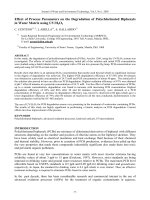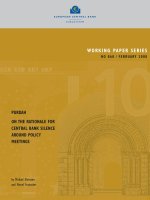WORKING PAPER SERIES NO 1395 / NOVEMBER 2011: ON THE IMPORTANCE OF PRIOR RELATIONSHIPS IN BANK LOANS TO RETAIL CUSTOMERS pptx
Bạn đang xem bản rút gọn của tài liệu. Xem và tải ngay bản đầy đủ của tài liệu tại đây (1.87 MB, 73 trang )
WORKING PAPER SERIES
NO 1395 / NOVEMBER 2011
by Manju Puri,
Jörg Rocholl
and Sascha Steffen
ON THE IMPORTANCE OF
PRIOR RELATIONSHIPS
IN BANK LOANS TO
RETAIL CUSTOMERS
ECB LAMFALUSSY FELLOWSHIP
PROGRAMME
ECB LAMFALUSSY FELLOWSHIP
PROGRAMME
1 We thank the Deutscher Sparkassen- und Giroverband (DSGV) for providing us with the data. Sascha Steffen`s contribution to the paper has
been prepared under the Lamfalussy Fellowship Program sponsored by the European Central Bank. We thank Rebel Cole, Hans Degryse,
Valeriya Dinger, Radhakrishnan Gopalan, Reint Gropp, David Musto, Lars Norden, Martin Weber, Vijay Yeramilli, participants at the EFA 2010
Frankfurt meeting, the FDIC-JFSR Bank Research Conference, the FMA 2010 meeting, the CAREFIN 2010 Conference at Bocconi,
the German Finance Association Meeting (DGF), and seminar participants at Drexel University, Erasmus University Rotterdam,
Georgia Tech University, University of Cologne, University of Mannheim, and University of Michigan for comments and suggestions.
2 Duke University, Durham, NC 27708, USA, and NBER; e-mail:
3 European School of Management and Technology, Schloßplatz 1, 10178 Berlin, Germany; e-mail:
This paper can be downloaded without charge from or from the Social Science
Research Network electronic library at />NOTE: This Working Paper should not be reported as representing
the views of the European Central Bank (ECB).
The views expressed are those of the authors
and do not necessarily reflect those of the ECB.
WORKING PAPER SERIES
NO 1395 / NOVEMBER 2011
ON THE IMPORTANCE OF PRIOR
RELATIONSHIPS IN BANK LOANS
TO RETAIL CUSTOMERS
1
by Manju Puri
2
, Jörg Rocholl
3
,
and Sascha Steffen
4
In 2011 all ECB
publications
feature a motif
taken from
the €100 banknote.
4 University of Mannheim, L5 ,2 , 68131 Mannheim, Germany; e-mail:
Lamfalussy Fellowships
This paper has been produced under the ECB Lamfalussy Fellowship programme.
This programme was launched in 2003 in the context of the ECB-CFS Research
Network on “Capital Markets and Financial Integration in Europe”. It aims at
stimulating high-quality research on the structure, integration and performance of the
European financial system.
The Fellowship programme is named after Baron Alexandre Lamfalussy, the first
President of the European Monetary Institute. Mr Lamfalussy is one of the leading
central bankers of his time and one of the main supporters of a single capital market
within the European Union.
Each year the programme sponsors five young scholars conducting a research project
in the priority areas of the Network. The Lamfalussy Fellows and their projects are
chosen by a selection committee composed of Eurosystem experts and academic
scholars. Further information about the Network can be found at -
financial-system.org and about the Fellowship programme under the menu point
“fellowships”.
© European Central Bank, 2011
Address
Kaiserstrasse 29
60311 Frankfurt am Main, Germany
Postal address
Postfach 16 03 19
60066 Frankfurt am Main, Germany
Telephone
+49 69 1344 0
Internet
Fax
+49 69 1344 6000
All rights reserved.
Any reproduction, publication and
reprint in the form of a different
publication, whether printed or
produced electronically, in whole or in
part, is permitted only with the explicit
written authorisation of the ECB or the
author(s).
Information on all of the papers published
in the ECB Working Paper Series can be
found on the ECB’s website, http://www.
ecb.europa.eu/pub/scientific/wps/date/
html/index.en.html
ISSN 1725-2806 (online)
3
ECB
Working Paper Series No 1395
November 2011
Abstract
4
Non-technical summary
5
1 Introduction
6
2 Data and summary statistics
13
A Loan and borrower characteristics
13
B Relationship characteristics
17
3 Empirical results on private information
18
A Univariate results
18
B Multivariate results
21
4 Private information and borrower incentives
to default
39
5 Conclusion
43
References
45
Appendices
48
Tables
51
CONTENTS
4
ECB
Working Paper Series No 1395
November 2011
Abstract
This paper analyzes the importance of retail consumers’ banking relationships for loan defaults
using a unique, comprehensive dataset of over one million loans by savings banks in Germany.
We find that loans of retail customers, who have a relationship with their savings bank prior to
applying for a loan, default significantly less than customers with no prior relationship. We find
relationships matter in different forms, scope, and depth. Importantly, though, even the simplest
forms of relationships such as transaction accounts are economically meaningful in reducing
defaults, even after controlling for other borrower characteristics as well as internal and external
credit scores. Our results suggest that relationships of all kinds have inherent private information
and are valuable in screening, in monitoring, and in reducing consumers’ incentives to default.
JEL: G20, G21
Keywords: Retail banking, relationships, default rates, monitoring, screening
5
ECB
Working Paper Series No 1395
November 2011
Non-Technical Summary
This paper analyses the importance of relationships between banks and depositors on borrower
default rates. Loan officers incorporate private information in the credit decision process as well
as in monitoring. We ask, is this relationships specific information valuable to banks as well as
borrowers? Are default rates effectively reduced? Does private information help banks to
become better at screening and to what extend does it influence the monitoring process? In
addition to that, we analyse borrower incentives to default conditioning on the intensity of the
relation with the bank.
We use a unique dataset that has information on consumer loans applied for as well as originated
by savings banks in Germany. Savings banks do 40% of retail banking in Germany, so this is a
significant source of credit for retail customers. The sample spans the time period between 2004
and 2008 and has information on the performance of more than 1 million loans made by 296
different savings banks. The default rates for these loans are calculated in compliance with the
Basel II requirements. In addition to the performance data, the dataset contains detailed
information on loan and borrower characteristics and in particular on the existence and extent of
prior relationships that loan applicants have had with the savings banks at which they apply for a
new loan. These relationships comprise of the existence of a current or savings account, the
usage of credit or debit cards, of credit lines, the amount of funds in these accounts as well as the
existence and performance of a prior loan. The available data also include detailed information
on each borrower, including age, income, employment status, and the length of the relationship
with the bank.
In other words, the data comprise information about the existence, scope and depth of the
relationship and, in contrast to prior literature, not only related to repeat loan relationships, but
also other (cross-selling) products, for example, checking and savings accounts at the time the
customer applies for the loan. Using selection methods, it is possible to address the question
whether banks use their private information rather in screening than in monitoring borrowers.
Using additional information about transaction account behaviour of our sample borrowers, we
are able to separate screening and monitoring from the question as to whether or not borrowers
with relationships are less inclined to default.
We find that loans of retail customers, who have a relationship with their savings bank prior to
applying for a loan, default significantly less than customers with no prior relationship. We find
relationships matter in different forms (transaction accounts, savings accounts, prior loans), in
scope (credit and debit cards, credit lines), and depth (relationship length, utilization of credit
line, money invested in savings account). Importantly, though, even the simplest forms of
relationships such as transaction accounts (e.g., savings or checking accounts) are economically
meaningful in reducing defaults, even after controlling for other borrower characteristics as well
as internal and external credit scores. We are able to access data on loan applications to assess
how banks screen. We find that relationships are important in screening but even after taking
screening into account relationships have a first order impact in reducing borrower default. Our
results suggest that relationships of all kinds have inherent private information and are valuable
in screening, in monitoring, and in reducing consumers’ incentives to default.
6
ECB
Working Paper Series No 1395
November 2011
1. Introduction
Understanding how banks make loans and under which conditions borrowers default on these
loans is important and has been at the forefront of the current financial crisis. An important
question is how should the process of loan making by banks be regulated to minimize risks? For
example, should the loan making process be entirely codified so that the potential for discretion
does not exist, and loans are made based on hard, verifiable information collected by the bank?
Allowing discretion to the bank could allow for the information obtained from relationship
specific assets to be incorporated to improve the quality of loans made. Likewise, what is the
value of a bank relationship to a customer? Is the bank better able to prevent default because of
prior relationships? Is a borrower less inclined to default on a loan if she has an extensive
relationship with his bank, because of the inherent value of the relationship? These are open
questions that are of interest to academics, banks, consumers, and regulators.
There is a vast theoretical literature on the relationships between banks and their customers.
1
Boot (2000) states, “The modern literature on financial intermediaries has primarily focused on
the role of banks as relationship lenders… (However) existing empirical work is virtually silent
on identifying the precise sources of value in relationship banking.” The importance of these
relationships has been documented in various contexts and in particular for banks’ lending to
corporate customers.
2
1
See, for example, Campbell and Kracaw (1980), Diamond (1984, 1991), Ramakrishnan and Thakor (1984), Fama
(1985), and Haubrich (1989).
2
See James and Wier (1990), Petersen and Rajan (1994), Berger and Udell (1995), Puri (1996), Billet, Flannery, and
Garfinkel (1995), Drucker and Puri (2005), and Bharath, Dahiya, Saunders, and Srinivasan (2006).
7
ECB
Working Paper Series No 1395
November 2011
Our paper adds to this literature studying bank-depositor relationships. In particular, it focuses on
the importance of existing relationships for both the bank, which can collect information, and the
customer, who has an incentive to maintain his relationship, by analyzing the loan approval
decision and subsequent loan performance. Given the significance of retail lending and deposit-
taking for banks, and given that banks are a valuable source of personal and consumer loans,
understanding the role of bank and retail depositor relationships is important. We ask both, how
and what kind of relationships matter in the granting of loans, as well as whether they affect
default rates.
The first key contribution of this paper is to recognize that relationships have multiple
dimensions which is essential in understanding both how banks collect private information as
well as how borrower and bank incentives are shaped. There are many different ways of thinking
about relationships. One could look at the length of relationships, the scope of relationships, or
the kind of relationships - whether it is a simple transaction account or a multi-prong
relationship. The literature has largely defined relationships in the context of giving repeat loans
to corporate firms, but in principle simple transaction relationships, or having multiple products
with the bank could matter.
3
A second key contribution of our paper is that we examine the
impact of different kinds of relationships that existed prior to granting the loan in reducing
default rates. Specifically, we show that these relationships matter in various forms, scope, and
depth, and even simple transaction or savings accounts make a difference. This is distinct from
information obtained from concurrent transaction or checking accounts opened at the time of
making the loan. From a practical point of view, our results imply that banks can make better
3
See e.g. Santikian (2009) who studies banks’ profit margins based on the cross-selling of non-loan products to
firms.
8
ECB
Working Paper Series No 1395
November 2011
credit decisions by requiring potential borrowers to open simple savings or checking accounts
and observing their transactions before deciding on the loan application. A third key
contribution of this paper is that we examine the sources of value of relationships at the loan
origination stage and find that relationships play an important role at screening loan applicants,
suggesting that the private information inherent in relationships is important. Even after taking
screening into account, relationships still have a first order impact in reducing borrower defaults.
This suggests a distinct value of existing relationships not just in screening but beyond
potentially from better monitoring based on private information as well as reduced incentives to
default by the customer. To the best of our knowledge, these results are new to the literature and
illustrate the value of relationships to both banks and customers.
A major limitation in studying the importance of retail banking relationships is the availability of
data in the context of an appropriate experiment design. This paper accesses a unique,
proprietary dataset which comprises the universe of loans made by savings banks in Germany as
well as their ex-post performance. These data are recorded on a monthly basis for each individual
loan and are provided by the rating subsidiary of the German Savings Banks Association
(DSGV). The data span the time period between November 2004 and June 2008 and comprise
information on the performance of more than 1 million loans made by 296 different savings
banks. The default rates for these loans are calculated in compliance with the Basel II
requirements. In addition to the performance data, we have detailed information on loan and
borrower characteristics and in particular on the existence and extent of prior relationships that
loan applicants have had with the savings banks at which they apply for a new loan. These
relationships comprise the existence of a current or savings account, the usage of credit or debit
9
ECB
Working Paper Series No 1395
November 2011
cards, the amount of funds in these accounts as well as the existence and performance of a prior
loan. The available data also comprise detailed information on each borrower, including age,
income, employment status, and the length of the relationship with the bank. All characteristics
are taken from an internal scoring system that is used by all our sample banks and available for
all loan applications. In addition, for a subset of the loan applications we also have detailed
borrower information that is not part of the internal scoring system and only known to the
savings banks. Finally, for a substantial number of loan applications we also have information
from an external scoring system. The important aspect for our analysis of the bank behavior is
that the scoring system provides a credit assessment of each loan applicant and a
recommendation for the loan decision, but the final decision remains with the bank and its loan
officers. The final loan granting decision is thus made by each individual bank, using its own
discretion and taking into account its respective ability and willingness to take on risks.
Furthermore, loan officers have some discretion themselves as to whether or not they approve a
loan application. In other words, there are some subjective elements in the screening process that
might very well be different for each respective bank and loan officer. These data thus provide
an ideal opportunity to investigate the sources of value of relationships from being able to collect
more information on a customer.
Our first set of tests examines whether loans with prior relationships have lower default rates
after controlling for observable borrower characteristics. We use a number of proxies for the
different forms of relationships: First, we examine the impact of relationships through
transaction accounts on default rates using five measures: (i) the existence of checking accounts,
(ii) relationship length, (iii) the usage of debit and credit cards, (iv) the existence of credit lines
10
ECB
Working Paper Series No 1395
November 2011
and (v) the usage of credit lines. Second, we examine the impact of relationships through savings
accounts on default rates using two measures: (i) the existence of savings accounts and (ii) the
amount of assets held in the savings accounts. Third, we examine the impact of relationships
through repeat lending on default rates. To summarize our results, we find that relationships that
have been built prior to loan origination significantly reduce the probability of default of
subsequently issued loans after controlling for borrower risk characteristics as well as internal
and external credit scores. This result is consistent with relationships both providing banks with a
unique advantage in monitoring their borrowers and creating incentives for customers to default
less often. We also examine the relative importance of each of our relationship proxies. While
prior literature highlights the importance of repeat lending relationships, this proxy turns out to
have a rather small impact on default rates relative to, for example, transaction account related
measures.
While these results establish a correlation between having prior relationships and default rates,
one can still ask what determines a relationship itself. If relationships are not random but are
related to certain (unobservable) borrower characteristics, relationship borrowers might be of
higher quality which explains lower default rates. We address this using a simultaneous equation
model in which we augment the main probit equation with an additional probit equation that
explains what factors determine relationships. To facilitate identification, we include an
instrument that proxies for the availability of savings banks to customers in their region. We test
the null hypothesis that both probit equations are uncorrelated and cannot reject this hypothesis
at conventional levels. These results suggest that there are no unobservable borrower
characteristics that bias our estimates of the impact of prior relationships on default rates.
11
ECB
Working Paper Series No 1395
November 2011
In a second set of tests we examine the sources of value of relationships. Do existing banking
relationships with retail consumers help banks to better screen these consumers when they apply
for loans and thus to reduce the default rates for these loans? Is there value to relationships
beyond screening? If so, does it stem from private information or other sources?
In order to separate screening from other benefits of relationships, we need to explicitly analyze
the loan granting process as we cannot observe the loan performance for those customers whose
loan application has been rejected. We use a simultaneous equation model augmenting the
default model with a second probit model that explains the loan granting decision. We find that
borrower characteristics that increase the likelihood of getting credit are negatively correlated
with default rates, which is consistent with banks using a screening policy to reduce default rates.
We further test the null hypothesis that the error terms of the loan granting and the default model
are uncorrelated (i.e. discretion does not matter for screening) and reject this hypothesis at any
confidence level. We also find that after controlling for sample selection, our proxies for
relationships are still negative and significant. Relationships thus provide value to banks in
screening, but they also provide value beyond this.
To investigate further the source of value of relationships, we make use of the detailed
information about transaction account behavior for a subset of our sample borrowers, which is
only known to the bank, but not included in the internal rating. Our results suggest that private
information is important both for screening and subsequent monitoring, but the different
relationship proxies still have explanatory power even after controlling for private information.
12
ECB
Working Paper Series No 1395
November 2011
These results suggest that other factors beyond private information are important for loan
performance and borrower defaults. One potential explanation of our results is that there are
reduced borrower incentives to default because of the potential value of relationships to the
borrower.
Our paper adds to the existing literature in several ways. There is a recent literature that analyzes
the benefits of bundling loans and checking accounts (Mester, Nakamura, and Renault (2007)
and Norden and Weber (2009)).
4
These papers explore the information banks gain over the
duration of the loans from checking account activity. Mester, Nakamura, and Renault (2007) find
that transaction accounts provide financial intermediaries with a stream of information for the
monitoring of small-business borrowers that gives them an advantage over other lenders.
5
Similarly, Norden and Weber (2009) show that checking account activity provides valuable
information for banks as an early warning signal for the default of small firms and their
subsequent loan contract terms. Related to these two papers, Agarwal, Chomsisengphet, Liu, and
Souleles (2009) document for credit card customers that monitoring and thus the availability of
information on the changes in customer behavior result in an advantage to relationship banking.
Our paper differs from theirs along several dimensions. While it is common to ask borrowers
taking a loan to open an account and important to study how the information in the account helps
the bank, i.e. instead of analyzing the benefits of providing jointly a loan and a checking account
to the same borrower, we examine the impact of relationships that existed prior to granting the
loan. Next, we show that relationships matter in various forms, scope and depth. Further, instead
4
This literature is related but distinct from the literature examining the importance of relationships for small firm
credit (Berger and Udell, 1995; Cole, 1998; Petersen and Rajan, 1994) .
5
For small and medium-sized business borrowers, there is also a growing literature on the collection and use of soft
information (Agarwal and Hauswald, 2007) as well as the use of discretion by banks (Cerqueiro, Degryse, and
Ongena, 2007).
13
ECB
Working Paper Series No 1395
November 2011
of analyzing the behavior of one bank we examine the loan making decision of 296 different
banks. Finally, we find evidence suggesting screening, monitoring, and borrower incentives as
distinct sources of value of relationships. Our paper also adds to the literature on traditional bank
specialness (such as James (1987), Lummer and McConnell (1989), Best and Zhang (1993),
Billet et al. (1995) and Dahiya et al. (2003)). These papers document a positive impact of loan
announcements on a borrower’s stock return at time of loan origination and provide evidence
that banks perform a special role in the financial system as monitors and information providers.
Our results are consistent with the traditional view: relationships are valuable in screening and
monitoring borrowers. However, we also find evidence for bank specialness beyond the
“traditional role” as a strong relationship with a bank reduces a customer’s incentives to default.
The rest of the paper is organized as follows. The next section describes the data that are used for
our analyses and provides summary statistics. Section 3 presents the empirical analyses on
private information, Section 4 shows the results suggesting borrower incentives to default,
Section 5 concludes.
2. Data and Summary Statistics
A. Loan and Borrower Characteristics
We obtain the performance data for the universe of consumer loans by savings banks in
Germany.
6
These loans are usually given on an unsecured basis, i.e. without collateral, and it is
6
The sample thus does not comprise applications for mortgage loans, checking accounts, or credit cards. Credit
cards are used differently in Germany than in the United States. They are issued by a bank and are directly linked to
the credit card holder’s current account in that bank. Payments are automatically deducted from this checking
14
ECB
Working Paper Series No 1395
November 2011
not possible to sell or securitize these loans unless they default.
7
The data for these loans are
recorded on a monthly basis for each individual loan and are provided by the rating subsidiary of
the German Savings Banks Association (DSGV). The data span the time period between
November 2004 and June 2008 and comprise information on the performance of 1,068,000 loans
made by 296 different savings banks. The default rates for these loans are calculated in
compliance with the Basel II requirements.
8
According to this definition, a borrower defaults if
one of the following events occurs: (i) the borrower is 90 days late on payment of principal or
interest, (ii) the borrower’s repayment becomes unlikely, (iii) the bank builds a loan loss
provision, (iv) the liabilities of the borrower are restructured with a loss to the bank, (v) the bank
calls the loan, (vi) the bank sells the loan with a loss, or (vii) the banks needs to write-off the
loan.
9
,
Our data includes flags for each of these default events and the associated date.
10
Defaults
are uniquely determined by each given savings bank; there are no cross-default clauses in
German retail lending. In addition to performance data, we have detailed information on all the
loan and borrower characteristics that the bank employs to assess a borrower’s creditworthiness.
In particular, we have information on the existence and extent of prior relationships that loan
applicants have had with the savings banks at which they apply for a new loan.
account at the end of each month. Customers can thus not default on their credit cards, but their payments may
exceed the credit line on their current account. In this case, the bank faces the repayment and default risk.
7
Given some public debate about the lending practices at one given savings bank, savings banks made clear to their
retail customers that no loan would be sold.
8
See “Solvabilitätsverordnung (SolvV) §125”, the “Baseler Rahmenvereinbarung Tz. 452-453 and the “EU-
Richtlinienvorschlag, Anhang VII, Teil 4”.
9
The second event is used if the default cannot be categorized into one of the other default events. For example, if
the repayment of the borrower is ‘unlikely’, but the bank does not build a loan loss provision because the loan is
fully collateralized, this category is chosen as default event.
10
Sales and securitizations of individual loans are uncommon in Germany, and when they occur they are for
commercial and industrial loans rather than retail credit.
15
ECB
Working Paper Series No 1395
November 2011
There are a number of unique characteristics of these data that make them particularly suitable
for the purpose of our study: First, they contain detailed information on individual loan
applicants, including information on their credit risk and their relationship status. Second, they
comprise detailed monthly information on the performance of each individual loan and in
particular its default. Third, the data on both the loan applicants and loan performance are highly
reliable, as they comply with the Basel II requirements. Fourth, the data are very comprehensive
as they cover the bulk of the universe of savings banks in Germany, which hold a market share in
retail lending of more than 40 percent in Germany. Also, the “regional principle” is an important
institutional setting associated with German savings banks. This implies that borrowers can only
do business with savings banks within the region they are domiciled in. Consequently, we do not
have to worry about endogenous matching of borrowers and banks in our sample. Finally, all
borrower and relationship characteristics are taken from an internal scoring system that is used
by all our sample banks.
11
The interesting feature for our analysis is that the scoring system does
provide a credit assessment of the applicant, but it serves as a guideline rather than a mandatory
prescription. The final loan granting decision is made by each individual bank also using its own
discretion and taking into account its respective ability and willingness to take on risks.
Furthermore, loan officers have some discretion themselves as to whether or not they approve a
loan application. In other words, there are some subjective elements associated with the banks’
screening process which might very well be different for each respective bank. Overall, the large
and comprehensive sample of loans by savings banks and the detailed information on loan
applicants’ relationship status and credit risk as well as on the performance of the approved loans
provides a unique opportunity to analyze the sources of value of relationships.
11
In principle, savings banks can also use information from external rating agencies, but they have to pay for this
information. It is thus available only for 86,628 loan applications. We use this information in our analysis shown in
Table 9.
16
ECB
Working Paper Series No 1395
November 2011
Table 1 reports the descriptive statistics for loans and borrowers. Over the first twelve month
after the loan origination, 0.6% of the approved loans default according to the above default
definition. The default rate increases to 1.3% when the loan performance over the full sample
period is considered.
12
Loan applicants have an average monthly income of €1,769, and most of
them are in the age cohort between 30 and 45 years, followed by the age cohorts between 50 and
60 years.
13
The loan repayment in percent of the borrower’s income amounts to more than 20%
only for 6.6% of the borrowers, for 54.5% of our borrowers it is less than 20%. For all other
borrowers, this information remains undisclosed. Most borrowers work in the service industry
and have been in their current job for more than two years.
The internal rating system does not comprise information on loan amounts, maturities, or interest
rates. However, more than 20 million monthly performance observations allow us to make
inferences in terms of loan maturities. Note that we can split our sample loans into two
categories, (1) loans that have either been repaid in full or defaulted, and (2) loans that have not
been repaid and have not yet defaulted or loans in default for which the banks have not closed
the account in expectation of future payments. In both categories, we analyze loans that have not
defaulted and infer that the average maturity is 14.5 months in both categories The performance
data also allow making inferences that pertain to loan amounts. We know the monthly repayment
rate (i.e. interest plus principal repayment) and can calculate the loan maturity of the repaid loan.
12
These relatively low default rates are very typical for consumer loans in Germany. According to 2008 estimates
by Creditreform (a German business information service), the average default rates for consumer loans in Germany
amount to 2-3% over the lifetime of the loan, while they amount to 5-6% in the UK and more than 6% in the United
States.( />Center/Fachartikel/International_Business/Archiv/Verschuldung.jsp)
13
The average monthly income of our sample borrowers corresponds to the average German inhabitant. For
example, according to the German Census Bureau, in 2006, the median net income in Germany was € 1,800 per
person which is very similar to the loan applicants in our sample.
17
ECB
Working Paper Series No 1395
November 2011
We thus can calculate the total repayment of these borrowers. On average, borrowers repay EUR
237 per month and EUR 3,100 in total.
B. Relationship Characteristics
Table 2 provides detailed information on the loan applicants’ relationship status including its
length and scope. It reports, in particular, whether loan applicants have an existing relationship
with the savings bank at which they apply for a new consumer loan and, if so, which types of
products they currently use or have used so far. Only 2.5% of the loan applicants have had no
relationship with their savings banks prior to the loan application. At the same time, many of the
existing customers have been customers of the savings banks for a substantial period of time. For
example, 47.6% of the loan applicants have been customers of the savings banks for more than
15 years, and more than 80% of them have been customers for at least 5 years.
The majority of customers have checking accounts with the savings banks prior to the loan
application. Checking accounts can be combined with debit and credit cards. The combination of
debit and credit cards is the most common type among customers; 46.5% of them have both
types of cards. 3.8% of the customers only have a debit card, while 18.3% of the customers only
have a credit card. 28.9% of the customers have no cards. Furthermore, 94.5% of the loan
applicants have an existing credit line at the time when they ask for a loan. These credit lines are
not used in 30.1% of the cases. If they are used, the usage ranges mostly between 20 % and 80%
of the limit of the credit line.
18
ECB
Working Paper Series No 1395
November 2011
The data set not only contains information on the checking accounts that loan applicants hold at
the savings banks, but also on their assets and prior loans. Table 2 shows that only 23.2% of the
borrowers have no savings account with their savings bank. While 19.7% of the loan applicants
have assets of less than €50, 36.3% have assets between €50 and €2,000, and 18.5% have assets
of more than €2,000. A substantial share of the borrowers already had prior loan lending
relationships with their savings bank before the current loan. 19.2% of the loan applicants have
had a loan in the past, and 12.1%, 17.4%, and 19.2% of loan applicants have had a loan within
the last year, the last two years, and the last three years, respectively.
3. Empirical Results on Private Information
Our objective in this paper is to examine the sources of value of relationships in reducing default
rates on consumer loans.
A. Univariate Results
To analyze whether relationships reduce default rates, we first examine the average 12-month
default rates in subsamples of relationships versus non-relationship borrowers
14
and find
significant differences. While the average default rate is 0.6% for relationship borrowers, it is
1.6% for non-relationship borrowers, respectively. The difference is significant at the 1 percent
level. We also analyze differences in ex-ante borrower risk. More precisely, we compare the risk
distribution of loans given to relationship versus non-relationship customers using Cramer’s V
which is a Chi-Square measure taking into account the number of observations in each
14
We define a relationship borrower as someone who has a transaction account relationship with the savings bank
before applying for a loan.
19
ECB
Working Paper Series No 1395
November 2011
subsample. We cannot reject the null that the risk distribution does not differ between both
subsamples (Cramer’s V is 0.045). In other words, while we find significant differences in
default rates, we cannot find differences in ex-ante borrower risk which suggests that
relationships are of first order importance in explaining as to why relationship borrowers exhibit
significantly lower default rates.
We next test the performance of consumer loans against a number of variables that capture the
existence, length, and scope of the relationship that a customer has with her savings bank. The
results are reported in Table 3 and show that customers with relationships, and in particular with
more intense relationships, default less often than other customers and that these results are
highly significant both from an economic and a statistical perspective.
As the first piece of evidence, model (1) of Table 3 shows that customers with an existing
relationship have a 1.0% lower default rate than customers with no existing relationship. This
difference in default rates is statistically significant at the 1% level. This is economically large
given the average default rate amounts to only 0.6% and corresponds to the difference in default
rates of relationship (0.6%) versus non-relationship loans (1.6%). Further, the difference in
default rates between new and existing customers is more than 1.5 times higher than the
unconditional mean. Model (2) shows that the default rates monotonically decrease with the
length of existing relationship. The benchmark case here is customers with a relationship of more
than 15 years. The default rates for customers with relationships between 9 and 15 years are
0.2% higher than for the benchmark case, and they increase up to 1.5% for relationships of less
than two years.
20
ECB
Working Paper Series No 1395
November 2011
The results in model (3) of Table 3 suggest that default rates decrease with the scope and thus the
intensity of the relationship between customer and bank. We introduce four indicator variables
equal to 1 if the borrower has (i) a credit and a debit card, (ii) only a debit card, (iii) only a credit
card or (iv) neither a credit nor a debit card. Borrowers without prior relationships are the
omitted group. All coefficients on these indicator variables are negative and significant
suggesting that relationship customers are less likely to default which is consistent with our
previous finding. Nonetheless, the biggest reduction in default rates is associated with borrowers
which have both a debit and credit card (only a debit card), which default 1.2% (1.1%) less often
relative to non-relationship customers. Model (4) shows that default rates also depend on the
existence of prior credit lines. The loans by customers with existing credit lines loans default by
0.6% less. Model (5) considers in more detail the actual usage of these credit lines. Customers
with credit lines have a higher default rate than customers without credit line only if their usage
is larger than 150% of the credit line. For all other customers with credit lines, the default rates
are significantly lower than for the benchmark group rates. In general, the default rates are
positively correlated with the usage of the credit line, i.e. customers with a positive account
balance exhibit the lowest default rates. Model (6) of Table 3 combines the different measures
used so far and looks at them simultaneously. The results are very similar to the previous results,
in particular the relationship length and the usage of debit and credit cards are still negatively
related to default rates, while the extent of the usage of credit lines is still positively related to
default rates.
21
ECB
Working Paper Series No 1395
November 2011
Starting with model (7), we analyze the effect of savings accounts on default rates. The results
show that the existence of a savings account decreases default rates by 0.5%. Model (8) shows
that customers with no savings accounts and with savings accounts of less than 50 Euros have a
0.7% and 0.6% higher default rate, respectively, than customers with more than 2.000 Euros on
their savings account. Overall, the volume of assets on a savings account is negatively correlated
with customer default rates; even customers with savings account assets of more than 50 but less
than 2.000 Euros are more likely to default than customers with assets of more than 2.000 Euros.
These results provide initial evidence that customers with existing relationships with the savings
bank at which they apply for a loan have lower default rates and that these default rates further
decrease with the length and scope of the relationships.
B. Multivariate Results
In this section, we analyze whether existing relationships reduce the default probability of
consumer loans controlling for a wide array of borrower characteristics. Our analysis proceeds in
two steps. We start by reporting the results separately for customers who have held transaction
accounts, savings accounts, and had repeat lending relationships with their savings banks before
they receive the current loan. Then we combine these measures in one specification in order to
analyze their relative importance.
22
ECB
Working Paper Series No 1395
November 2011
B.1. Relationships from Transaction Accounts
Table 4 reports the results for customers who have had a transaction account with their savings
bank before applying for a loan. This table presents the results of a probit regression. The
dependent variable is a binary variable equal to 1 if the borrower defaults within the first 12
months after loan origination. Our main inference variables are relationships characteristics as a
result of relationships via transaction account (relationship length, credit and debit cards, credit
lines and usage of credit lines). Models (2) to (6) consider those borrowers that have a checking
account with the savings bank (i.e. we drop loans by “new customers”). In model (2), the omitted
relationship variable is customers with a relationship longer than 15 years; in model (3)
borrowers without a debit and credit card are omitted; in model (5) customers without credit
lines are omitted; in model (6) customers with a relationship longer than 15 years, the group of
customers with no credit and debit card and without credit line are simultaneously omitted. The
coefficients for borrower industries
15
as well as intercept and time fixed effects are not shown.
Only the marginal effects are shown. Heteroscedasticity consistent standard errors clustered at
the bank level are shown in parentheses (Petersen (2009)). The control variables are the monthly
income of the loan applicant, her repayment burden, which is measured by the ratio of the
expected monthly loan repayment amount - if the loan application is approved - and the available
income, the loan applicant’s age as well as her job stability.
16
This is a dummy variable that takes
a value of 1 if the borrower has been in her current job for more than two years and 0 otherwise.
The analysis also controls for the industry in which the borrower works and includes time fixed
15
“Industry” has to be understood in a very broad sense and comprises the most important industries borrower work
in, for example, the service sector, public sector, construction, whether the borrower is unemployed or retired, but
also the following industries: communications and information; energy and water supply, mining; hotel and catering;
municipalities; agriculture; banking; insurance; not for profit company. But it also comprises: housewife; apprentice;
high school student; student; army; houseman and civil service.
16
All variables are defined in Appendix I.
23
ECB
Working Paper Series No 1395
November 2011
effects. The results in Table 4 show that default rates are decreasing in the borrower’s income
and tend to increase in her repayment burden. The default for this variable is a ratio that exceeds
20% of the loan applicant’s monthly income. The borrower’s age does not have a significant
effect on default rates for borrowers below the age of 30 in some models, in comparison to the
default age of larger than 60 years. However, borrowers between the age of 30 and 60 have a
higher default probability than borrowers at the age of 60 and above throughout. Job stability
also has an important impact on default rates. Customers who have been in their current job for
less than two years default 0.3% to 0.5% more often than customers who have been in their
current job for more than 2 years. This result is statistically significant at the 1% level.
The coefficients of our relationship proxies are in most cases significant at the 1% level and
similar in magnitude compared to Table 3. As shown in model (1), the existence of a relationship
lowers the default probability by 0.6%. Model (2) shows the results for different relationships
length categories. The results suggest that defaults decrease with the length of a relationship and
are least likely for the customers with the longest relationship duration. Borrowers with a
relationship length less than 2 years have a 1.4% higher probability to default compared to
customers with more than 15 years of relationships, ceteris paribus. Apparently, even the
existence and the first few months of a relationship have a significant effect on default rates. This
finding is consistent with anecdotal evidence we obtain talking to loan officers at a large private
bank in India who does lending to SMEs that are also difficult to evaluate. One of their key
models is to ask firms to open a checking account and observe them for 6 months before making
a loan decision. The loan officers claim they could substantially reduce default rates with this
24
ECB
Working Paper Series No 1395
November 2011
model. It is noteworthy that the anecdotal evidence from India matches our results on retail
lending in Germany.
Model (3) takes into account the intensity of a relationship by analyzing the impact of different
combinations of credit and debit cards that transaction account customers had before applying
for a loan. Customers that had both credit and debit cards or simply debit cards have the lowest
default probability and have 0.3% lower default probability than customers who have held
neither a credit nor a debit card. Model (4) tests for the effect of the existence of a credit line in a
customer’s transaction account. The results suggest that that the existence of a credit line
significantly lowers the customer’s default probability. Model (5) considers credit lines again
more carefully, and the results suggest that the usage of credit lines is positively correlated with
default which is consistent with the findings of Mester, Nakamura, and Renault (2007) and
Norden and Weber (2009). The coefficients are very similar to those in the previous univariate
analysis. Finally, model (6) considers the different relationship variables simultaneously. The
results are again very similar to those for the separate analysis of the different characteristics.
Taken together, the results for the transaction accounts suggest that the existence of a prior
relationship between bank and customer reduces the subsequent loan default rates for the
customer, and that these default rates decrease in particular for longer and more intense
relationships.
B.2. Relationships from Savings Accounts
Table 5 repeats the previous analysis for customers who have held a savings account before
receiving a consumer loan using probit regressions. The dependent variable is a binary variable









